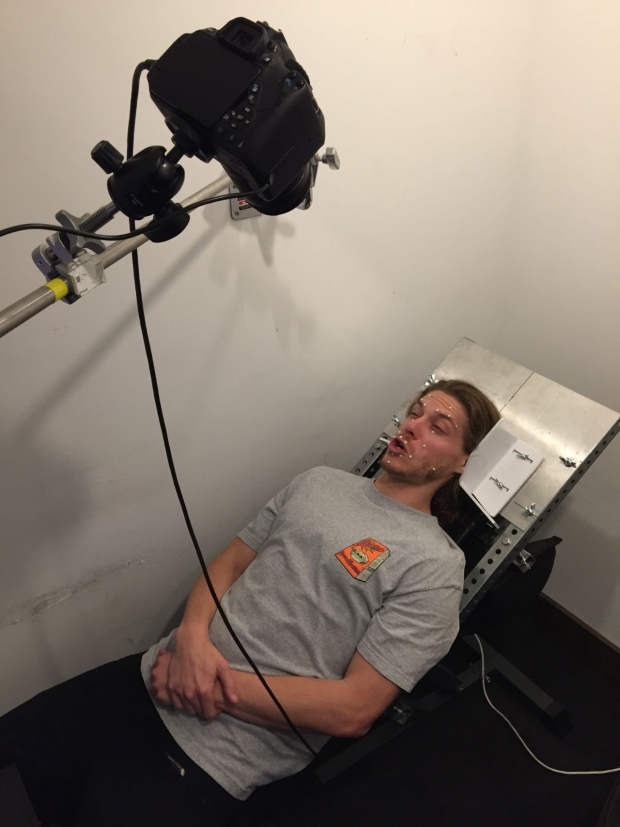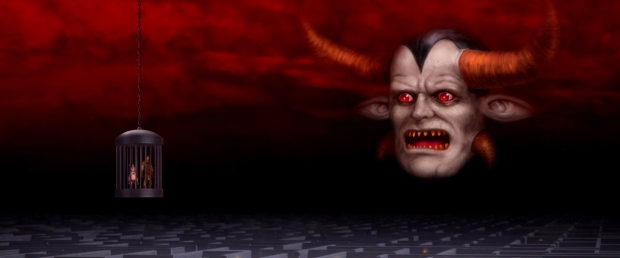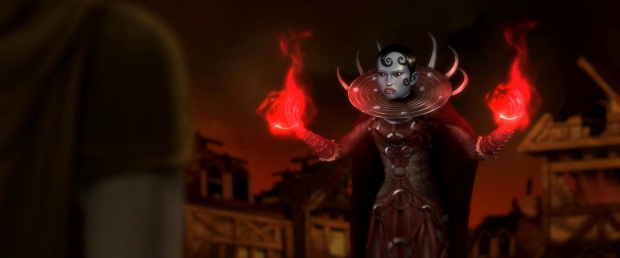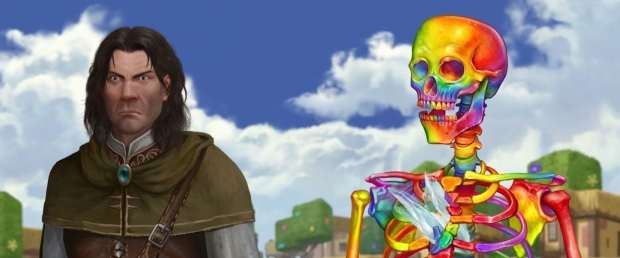For creators Andrew Koehler and Benjamin Martian, Adult Swims’ satirical fantasy series about bold adventures and murderous quests proves you can still get plucked from obscurity and given an animated series… without a pitch.
With the recent launch of a 10-episode second season of Adult Swim’s Tigtone, we once again visit the surreal fantasy world – awash in bold adventure and murderous quests - of our overly dramatic sword-wielding hero, Tigtone. Quirky seems like an understatement; Andrew Koehler and Benjamin Martian’s animated fantasy comedy, born from thwarted live-action filmmaking and far too much Magic: The Gathering gameplay, is a uniquely designed, oddly disquieting and extremely funny animated series that proves, without a doubt, miracles can and do happen. Yes, Virginia, artists still do get plucked from creative obscurity and given animated series. Without a pitch.
This much, we know: Tigtone is the saga of a quest-addicted hero who slashes his way across a satirical fantasy universe with melodramatic ferocity, always obeying the letter of the law but never its spirit. We also know that the show is executive produced by the pair along with Blake Anderson (Workaholics), and produced by Titmouse, Babyhemyth Productions and Williams Street. Season 2 has a lot of returning talent: Nils Frykdahl from the bands Sleepytime Gorilla Museum and Free Salamander Exhibit as Tigtone; Debbi Derryberry as helpful Helpy helper; Jeffery Combs, Cree Summer, John DiMaggio, Bill Corbett, Lucy Davis, Gary Anthony Williams are also back. New for this season are Maria Bamford, who plays Spaceress, a new villain, Phil Lamarr, and EG Daily.
More importantly, we know that Koehler and Martian’s circuitous, seemingly aimless, but always amusing path to animated series creators is thoroughly fascinating. And uplifting, because we can all take heart in a story about ordinary film school graduates rich in obsessive storytelling passion but poor in actual achievement, with odd senses of humor, who hang out all day playing games or watching The Lord of the Rings trilogy incessantly as they work on yet another version of another script for another project they’ll probably never make, until someone happens to fall upon the mad short they took four years to produce… and the rest, they say, is history.
Koehler and Martian shared their meandering path to a spot on the Adult Swim programming schedule in a crazy, wonderfully enjoyable interview, highly edited for readability.
Dan Sarto: Your show is so visually distinctive compared to other animated comedies. How did this all begin? In what fever dream did you cook up Tigtone?
Andrew Koehler: Uh, the genesis of just the whole idea, narratively, of doing this fantasy parody, or like, a cinema parody stuff that we do, it came like… we were fresh out of college… gosh, I think we were still in college, like in 2003 or 2004… no, actually it was right out of college. Our friend Josh and I were playing [the card game] Magic: The Gathering on the floor of my apartment. We were unemployed, having just graduated, and had nothing to do but play Magic. And a friend came over and he's like listening to us play, and fantasies was not his world at all, and he says, “Do you guys hear yourself?” And, right there, suddenly, it was the spark of, “Wow, I need to explore this, his fantasy contempt.”
Benjamin Martian: We went to the Minneapolis College of Art and Design from 2000-2004. Andrew graduated with a BFA in animation and I got a BFA in photography. We left art school like most art school graduates and were immediately and terminally unemployed. I admittedly never played Magic with the guys. I did play D&D in Junior High though.
And I think Lord of the Rings had come out around that time, so that kind of re-ignited for both of us our love of 80s fantasy movies, specifically like Krull and Legend, you know, and the Ralph Bakshi stuff from the 70s. If I remember correctly, we wanted to remake a movie that you [Andrew] had already made. You’d made like this vampire movie. And because we were talking about fantasy stuff so much, we’re like, “Let's just remake that movie, but with fantasy characters,” as a kind of a meta joke that only the two of us would get. Right? And then I think that just turned into a completely original script, which was a live-action feature called Dschinghis.
AK: Yeah, when it started, as I said, we initially pictured all this as live-action. We named it Dschinghis after Dschinghis Khan, the Austrian disco band, based off Genghis Khan, just because Dschingis sounds like dingus and we needed a MacGuffin for our script. So, it became Dschinghis. You know, it's just lots of free association. That's also where the sort of voice, that incredibly saturated importance that is completely meaningless and completely unearned, came from. Making the whole script sort of like the blueprint for what would become the Tigtone DNA, which was, you do these cinematic moments, but you don't earn them. Narratively, you don't earn them. You just sort of go through the motions and make it feel like it makes sense, like it's really heavy, but it's totally nonsense. You know, our director, Freddy [Cristy] refers to it as selling bullshit to the audience. Like, as long as we sold the bullshit, it’s fine. We can move on.
DS: So how did you get from Dschinghis Khan to Tigtone Season 1 on Adult Swim?
BM: So, we decided to do a live-action short. We wanted to create something in this fantasy universe as a proof of concept type thing. So, we created this character Tigtone, who was designed to just be a kind of a blank, RPG archetype, Aragorn Ranger, quest-type guy. But we were woefully under-prepared for such a massive thing.
AK: The idea was to do a short 10-minute live-action piece. And even that was just too difficult. I mean, the technology was so new at that point, on a consumer level, to do compositing and stuff like that. You know, we brought like blue and green sheets out into the woods and shot stuff. We actually did shoot a Tigtone scene. We shot one, actually, one element, which was the lobster guards, these guardians that were these giant samurai lobsters. I remember my sister, who was a costume designer, she made a Tigtone costume. I made the Tigtone journal with a quill; I even carved a wooden inkwell. We were even looking at people to cast for Tigtone. We shot just a couple of things with these guards and realized it was just too…even that was too much. That was too far beyond our means at the time.
BM: Just taking a little step back… so, we wrote this live-action feature film, and Prince Lavender was actually the lead. He was a much different Prince Lavender than is in the show. But Andrew and I just became obsessed with what we called the Dschinghis universe that we were creating. We still kind of refer to it as the Dschinghis universe. We started to write a lot of other shorts, and some of them were with characters from the feature, and some of them were new characters. One of the new characters was Tigtone, which we just happened to really like a lot. So, we wrote a piece, The Walkings of Tigtone, and from there we started to produce the Tigtone short.
DS: We’re getting closer. How did you go from writing a live-action Tigtone short to an animated Tigtone series?
AK: The next step was well, it's basically, the reason why we couldn't make it with the technology we had was because, in order for our jokes to come across, it has to look great; it has to look like it takes itself really seriously. And that just sucks, you know. We couldn't do that. So, I started to look into doing motion-capture and 3D animation using off the shelf 3D models that you could buy, and things like that. You know, anything that could speed along the process. I personally am not capable of creating beautiful fantasy art. This was a couple years later already when I moved to Los Angeles. Like 2008. I was kind of working on Tigtone on the side. I was messing around with motion-capture. I knew After Effects really well, but there was no easy way at the time, in 2008-2009, for me to get motion-capture and all this morphing to work.
But I did some digging and found a couple of scripts that I duct taped together to make motion data work with warping. And I was like, “Whoa, this looks terrifying and amazing!” I’m like, “We can do anything with this.” I did a test with just the camera on the laptop, just going “Mmm mmm mmm mmm mmm” with my lips and immediately, my imagination went, “We can do anything we want! We can make any piece of art do anything we want!”
BM: That was kind of the goal. Why can't we just make Magic: The Gathering cards come to life? That was the jumping off point. We know we can't make live-action stuff look like fantasy art. So why don't we just use the fantasy art?
AK: And that’s when we knew, that’s pretty much the right way to go.
DS: So, from that discovery of a production technique that could potentially move you closer to making your short, how you get from there to the final animation style you chose for the series?
AK: Well, between the discovery of the motion-capture warping capabilities, and the TV series, in 2011 we did a Kickstarter campaign to fund the short film, The Begun of Tigtone, that was really the proof of concept for the animation style. It was a 14-minute piece that took around four years of R&D blood, sweat, tears and turmoil. We finished the short in 2014.
BM: Just before The Begun, the reason we started doing tests with the character of Tigtone was because we had started to try and produce the live-action Tigtone. So, it was sort of like, “OK, I’ll just use Tigtone and see what I can do.” The Begun kind of started as a series of tests that just kept expanding and getting rewritten. And then, it turned into a real thing. But I remember… I wish I could find it… I remember an early test you [Andrew] sent me, and my reaction was like, “This is terrifying!” I can’t find that email, but… I wish I could.
Andrew got art for The Begun by finding people on DeviantArt. Yiğit Köroğlu, who does Tigtone for the series, did the main Tigtone paint for The Begun.
DS: So, you did the Kickstarter campaign, it took you four years to make the short, with the character of Tigtone, called The Begun of Tigtone. How did that take you to Adult Swim and the series?
AK: So, after we finished, we put The Begun up on YouTube. The artist Skinner saw it online, and he was friends with Blake Anderson… Skinner was like staying over at Blake's house or something and he's like, “Hey, I want to show you this thing I saw online,’ and he was floored by it. He sent me an email directly and was like, ‘Hey, I'm good buddies with the folks at Adult Swim. This is amazing and I would love to see more of it.” And the rest is history, as they say. That was in the fall of 2014.
BM: It's like that thing when you hear about someone getting plucked off YouTube and given a show, and you’re like, “Yeah, that doesn't really happen.” Totally happened. We didn't even have to pitch it to Adult Swim because the short was already done. So that first meeting with Adult Swim was really not even a pitch. It was just sort of a conversation about the show’s potential… how do we make a story out of this? Does Tigtone have friends? How would this work as a series? Because The Begun was very much like, literally, a series of tests that just kept getting expanded until they met up with each other and formed some semblance of a cohesive story, you know? So that was really the first conversation about how do we form this into something that we can recreate, over and over again? The Begun was such a huge, elaborate, um, convoluted, complicated process, right?
We did do a pilot with Adult Swim that was not the The Begun. We started in October 2016 and delivered in April 2017. We didn't have time or budget to do any research and development, and just had to dive right in and since the technique was so crazy everyone was learning how to do this while doing it--a little like riding a train while you're also laying the track. It was madness. But Titmouse was amazing, and we did the best we could with the time and money we had. The pilot aired in May 2018. We started pre-production on the series in July 2017 and it debuted in January 2019.
The fact that Adult Swim took a chance on Tigtone, and on us, is really a testament to how much they are dedicated to creating new and unique content, and how supportive they are of creators. They really understand the creative process and are involved as a collaborator in that process, but for the most part they are really hands-off and just let us do our thing because they know that's the best way to get unique shows.
DS: OK, so we finally got to Adult Swim and the series. Can you walk me through how this show is produced? The integration of facial motion-capture and limited digital puppet-style animation is both hilarious and disturbing to watch, in a good way.
AK: Pretty much every everything is done in After Effects. It's all Photoshop paintings, done by our team of kick ass artists, that go through to After Effects. Then, in After Effects, we've got both the art and the flat 2D footage of our faces filmed in our stabilized mocap chair. That footage is first edited and synced up to the shot. Then we do all the compositing and face warping, all the body puppet movement. And testing.
BM: There's a lot of work involved. The first thing we need is the actual voice recording of the final performance. You know, we first record Nils [Frykdahl] and Debbie [Derryberry] as Tigtone and Helpy; we have to lock in their lines. And then we get in the mocap chair and perform each of their lines on a loop until we get our performance sync’d up with their vocal.
DS: So, you guys must record all the facial mocap for every line of the voice actors’ dialogue, sync’d to their voice performance?
BM: Correct. It's like two performances must come together to make the character. Actually, it’s more like three, if you consider the animators’ performances, because they do a lot too. So, it's the vocal performance, then our face doing the physical face performance, and then the animators taking that information and bringing all of it together to create the final character performance.
DS: What is it about fantasy storytelling that is so compelling to you guys?
BM: With the fantasy narrative of so many films, the logic of a fantasy narrative is so ridiculous, but they explain it, and set it up so that your suspension of disbelief is… you buy it, you know?
And so, for us, we don't ever parody fantasy. That's not the goal here. We love fantasy. We don't want to make fun of it. For us, the logic of the Tigtone universe is just totally absurd, but it's the rules of the world, so we adhere to them with utmost seriousness. The foundation of Tigtone is so ridiculous and absurd, we don't have to tell jokes, we just write stuff and make sure we adhere to our rules and it becomes totally absurd. Every once in a while, we allow ourselves to be overtly silly, or to write a specific joke. But for the most part, it's kind of just hanging these narratives on this already absurdist foundation.
Like the way they talk. We use a lot of grammar, like throwing stuff in a grammatical blender, and like, that's our fantasy language. Rather than having Elvin or some kind of fake British dialect, they just speak with poor grammar, you know? That’s our fantasy language.
DS: So, Titmouse is handling the animation? They have some amazing talent at that studio. How much was production affected by the pandemic?
AK: We had about half the episodes delivered by the time the lockdown went into effect. And we were able to move over to a remote system within a matter of like two weeks. We still finished production on schedule and everything. We used this software called Syncsketch to do dailies. Obviously, it wasn't ideal, but it managed.
BM: The Titmouse folks are all super fantastic. And I think it's worth pointing out, after that first Adult Swim meeting, we had to look for a studio. I remember we had that first meeting with Titmouse and I was like, “They’re going to look at the way the show is made and they're gonna be like, ‘This is insane, why would you make a show like this?’ And we had the meeting and we told him how it was made, and they were like, “This is insane. Why would you make a show like this? Uh, let's do it!” They're all fans of the genre and super fans of the show itself. Everyone is so enthusiastic to work on it and they just put in so much extra work.
From the character designer to the prop designer and painters, to the background artists, they put in so much work, and it shows.
This new season looks amazing. Season 1 had such a huge learning curve, all around, because first of all, we had no idea how you would make this show with a pipeline where you could do it over and over again. So, there was a huge learning curve there. We basically had to redesign an entire production pipeline around the Tigtone style because the normal animation production pipeline doesn't work. I think when we first started, we were looking at numbers like it was going to take us 50 years to make this one episode, according to the normal animation pipeline.
But by the end of Season 1, the Tigtone machine had been built. So, for Season 2, we didn't have that learning curve. Everybody knew how to do it, so we hit the ground running from day one. It was great to like have a whole season where everything just looks sick, everything works so well, everything had come out so great. I'm really excited for people to see the new episodes because they look so good. They’re just they're so tight, you know?
DS: What can we expect to see in Season 2?
BM: For Season 1, we were very aware of making each episode spin on fantasy tropes as a way of introducing our world. Like here's how OUR hero does things, or what are wizards or unicorns like in our world. So, Season 1 was essentially world building episodes. Season 2 is very much just playing in the sandbox and having fun with all our Tigtone toys. We got to expand the universe and bring in more non-humanoid creatures and monsters. That was kind of a goal of ours for this season. We do introduce a main villain for Tigtone. It was also really fun to piggyback off the last episode of the first season where Tigtone basically destroys everything so he can have all these quests. Season 2 literally picks up exactly at that same moment where Season 1 left off, which is pretty cool.
AK: And we just leave it destroyed. We're like, “Oh, Tigtone destroys the world at the end of Season 1. Uh… okay.” There’s a very Mad Max vibe to our fantasy world. There’s also lots of bondage costume stuff that you might expect them to wear in a wasteland.
Dan Sarto is Publisher and Editor-in-Chief of Animation World Network.

















